Teacher's guide
Objective
The goal of this presentation is to provide teachers of students in grades 7-11 with resources to help them understand the risks of cannabis use on their mental health, while also encouraging them to pursue activities that can help them feel their best. The first part of the experience educates participants about the effects of cannabis on their brain and mental health, while the second part provides youth with alternative activities that produce similar chemical reactions in the brain but in a healthier way.
By encouraging participation in engaging experiences that tap into physical activity, music, and art, the lesson aims to spark a passion for an activity that is more beneficial to their overall health. This document aims to provide you with tips and tools to host your own Pursue Your Passion lesson and increase awareness of the health risks associated with cannabis use, particularly to mental health.
Engaging youth
By working through the various steps, you can build your own Pursue Your Passion lesson to deliver factbased information, lead thought-provoking activities, and inspire youth to pursue a passion, without the use of cannabis.
There are many reasons youth decide to use cannabis: to relax, to relieve stress and anxiety, to have fun, to
experiment, to fit in with friends, or just to try something new. Some youth might see cannabis as a natural plant and think it’s safe.
There are ways to engage with youth that promote open and positive communication:
- Active listening (ask open-ended questions, be positive, encourage discussion)
- Get in the right frame of mind (put yourself in their shoes)
- Respond clearly to their questions and comments
- Be clear about your intent and let them know that you hear them
- Be calm, relaxed and offer empathy and compassion
To learn about more strategies for talking with youth about cannabis, see Talking with teenagers about drugs and Talking with your kids about cannabis
Planning a Pursue Your Passion lesson
Breakdown of a Pursue Your Passion lesson
Estimated duration: 30-45 minutes
| Introduction | (5-10 mins) |
| Learn the facts on cannabis and the brain | (10-15 mins) |
| Engage in activities you’re passionate about | (2-5 mins) |
| Conclusion and questions | (10-15 mins) |
There are a few things to consider…
- Location: try finding a place where you can spread out and move around such as a gym or recreational area. If you’re learning from home, encourage the youth to find an area in their home where they can move around.
- Time: your lesson will take approximately 30 to 45 minutes.
- Resources available: get creative with the resources you have (e.g., sporting equipment, art supplies.)
- Technical requirements: you will need a screen with a projector or a large monitor with internet access for the 360° Brain education tool and the creative activities listed.
360° Brain education tool
The compounds in cannabis affect the same systems in the brain involved in brain development. Through the Pursue Your Passion experience, participants learn the facts on how cannabis affects each area of the brain, and what could potentially happen long term.
With the 360° Brain Education tool application, participants will be able to access different parts of the brain and learn about what they do and the impact cannabis use can have on each one. It is important to stress that frequent cannabis use can have a significant impact on adolescent brains, as the brain is still developing up to the age of 25. Youth are especially vulnerable to the effects of cannabis on brain
development and function.
We encourage educators to familiarize themselves with the platform before your lesson. In the lesson, educators will focus on the areas of the brain that affect thinking, planning and decision-making.
Tip for a better experience: Set up on a projector so multiple people can view the 360° Brain at one time.
Additional resources:
For a list of comprehensive cannabis resources, see Talk about cannabis
Pursue Your Passion lesson guide
Before getting started please ensure you have the following set up...
- The Pursue Your Passion slides are set up and visible to the students
- Students have access to a computer or tablet for creative activities (2 minute activity) and 360Students have access to a computer or tablet for creative activities (2 minute activity) and 360° Brain Education Tool Brain Education Tool
- There is adequate space for students to perform physical activities (2 minute activity)
- You have access to a timer
Teacher's notes legend
| Speaking Points are in quotations “ ” |
| Directions are in brackets ( ) outlined in green |
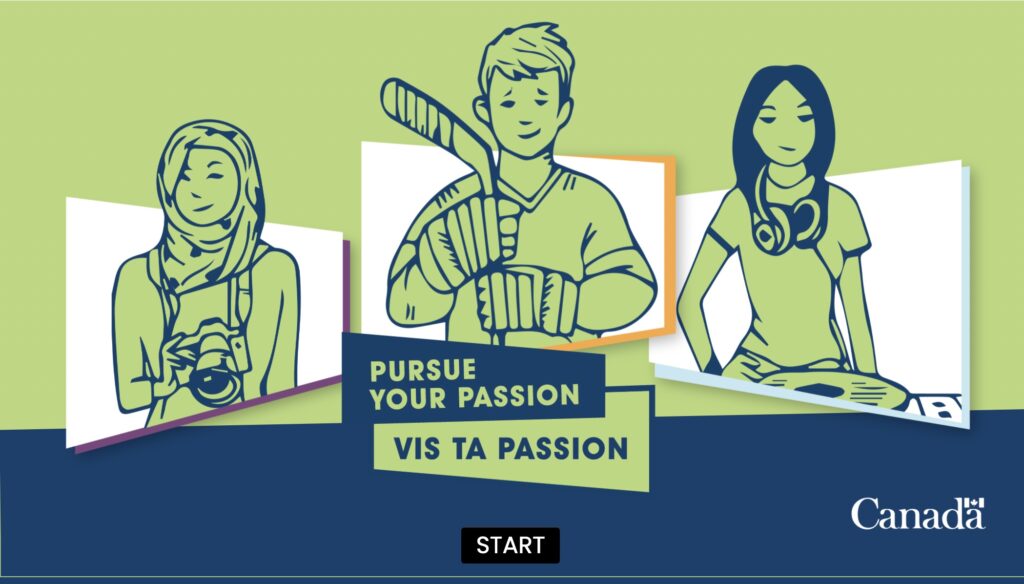
Teacher's Notes
“Did you know that youth and young adults who consume cannabis, especially cannabis containing THC, are more likely to experience mental health problems?
This happens because cannabis can interfere with healthy brain development until your mid 20s.
Youth and young adults who use cannabis are more likely to experience long-term mental health problems including cannabis dependence or cannabis use disorder, anxiety, depression, and even schizophrenia in those who have a family history.”
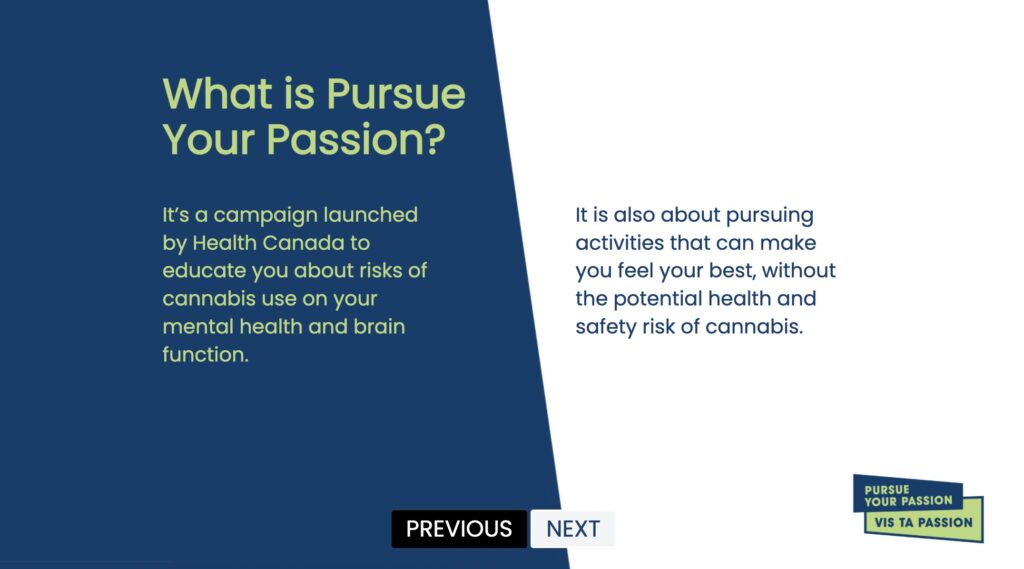
Teacher's Notes
“What is Pursue Your Passion? It’s a campaign launched by Health Canada to educate you about risks of cannabis use on your mental health and brain function.
It’s also about pursuing activities that can make you feel your best, without the potential health and safety risks of cannabis.”

Teacher's Notes
“Let’s start with a pop quiz: At what age is your brain fully developed? 5 years old, 10 years old, 15 years old, 20 years old or 25 years old?”
(Ask students to shout out what they think the correct answer is. Submit the most popular answer on behalf of all the students.)
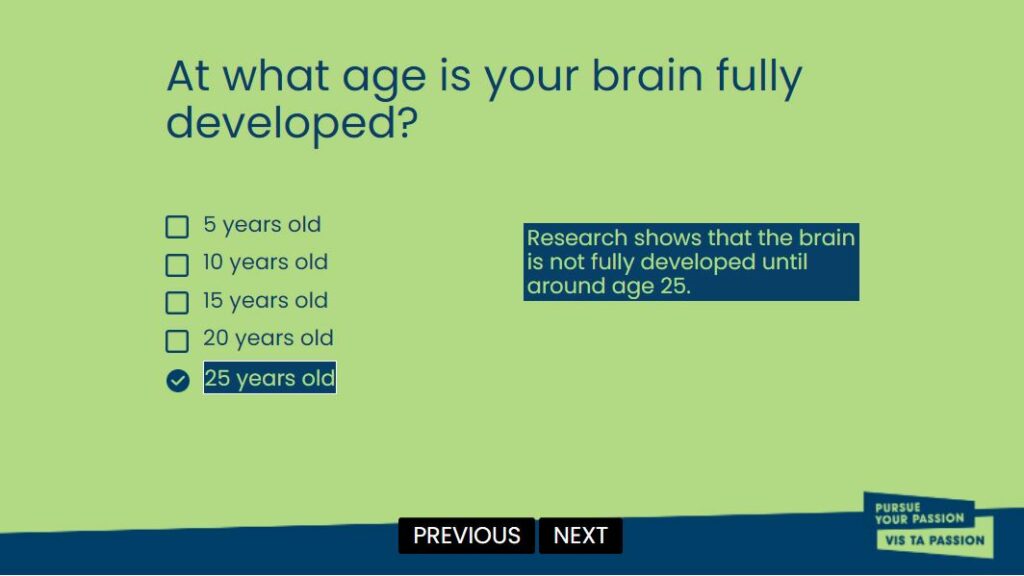
Teacher's Notes
“The correct answer is 25 years old. Research shows
that the brain is not fully developed until around age
25. Youth are especially vulnerable to the effects of
cannabis on brain development and function. The
earlier you start using cannabis, the more harm it
can do to your health.”
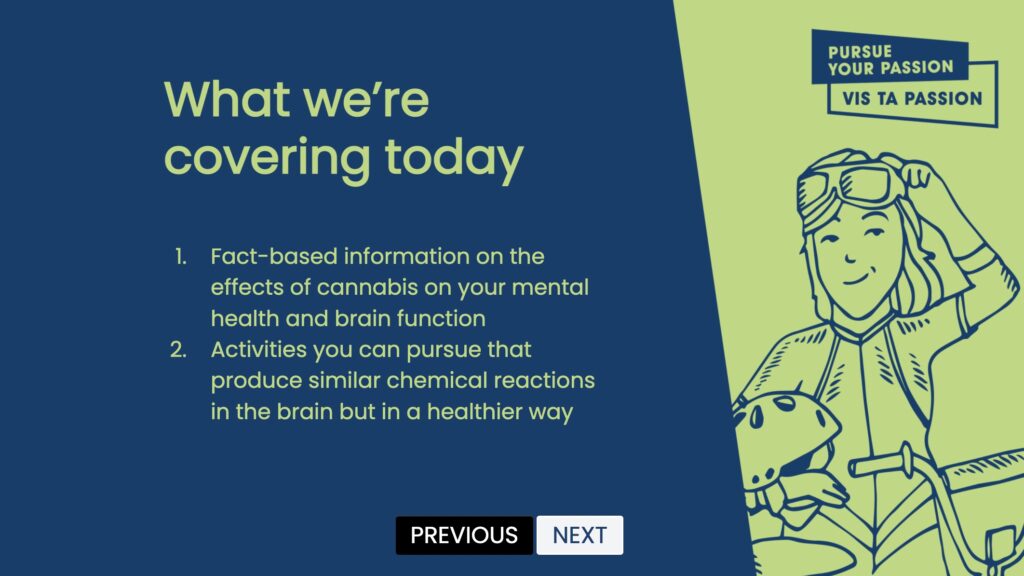
Teacher's Notes
“What we’re covering today
- Fact-based information on the effects of cannabis on your mental health and brain function
- Activities you can pursue that produce similar chemical reactions in the brain but in a healthier way”
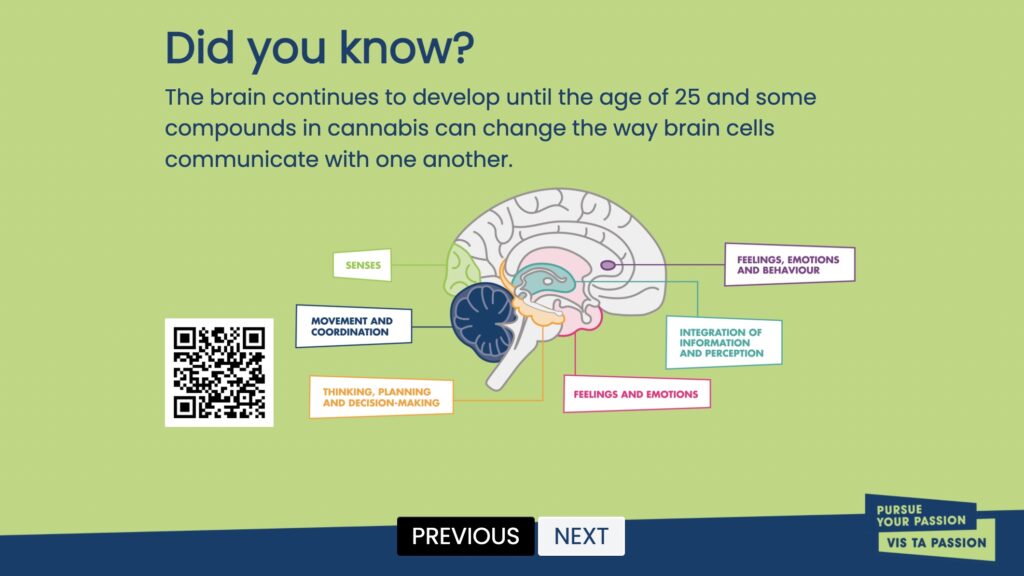
Teacher's Notes
“The brain continues to develop until the age of 25 and some compounds in cannabis can change the way brain cells communicate with one another.
Cannabis can impact different parts of the brain and can potentially impact the following long-term:
Your:
- Senses;
- Movement and coordination;
- Thinking, planning and decision-making;
- Feelings, emotion and behaviour;
- Information and perception
Let’s learn the facts on how cannabis affects each
area of the brain, and what could potentially happen
long term.”
(For more information visit: https://www.canada.ca/en/healthcanada/services/drugsmedication/cannabis/resources/cannabis-brainknow-facts.html)
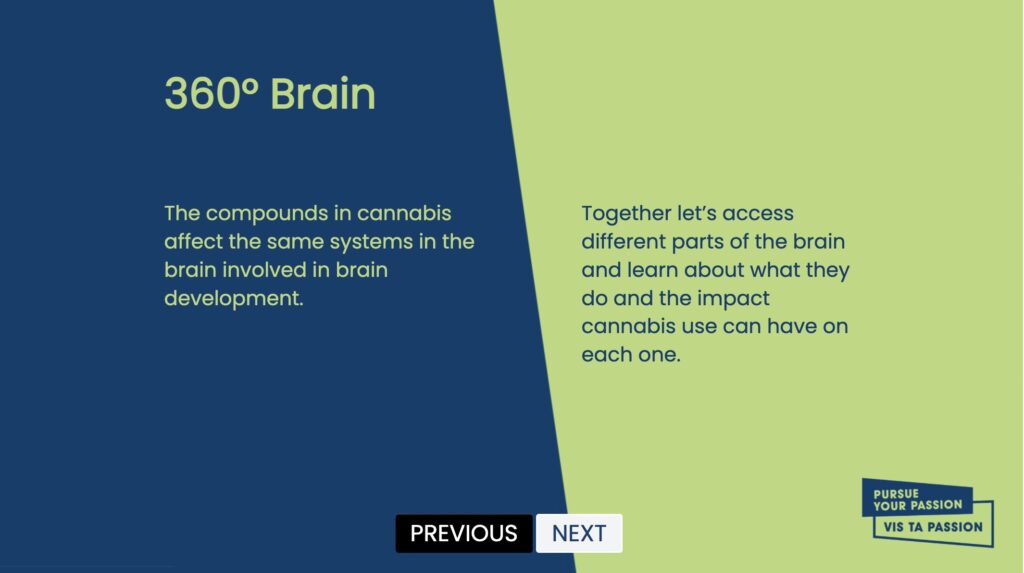
Teacher's Notes
“The compounds in cannabis affect the same systems in the brain involved in brain development.
Through the Pursue Your Passion experience, you can learn the facts on how cannabis affects each area of the brain, and what could potentially happen long term.
With the 360° Brain Education Tool, you will be able to access different parts of the brain and learn about what they do and the impact cannabis use can have on each one.
It is important to stress that frequent cannabis use can have a significant impact on youth and young adult brains, as the brain is still developing up to the age of 25.
Youth are especially vulnerable to the effects of cannabis on brain development and function.”
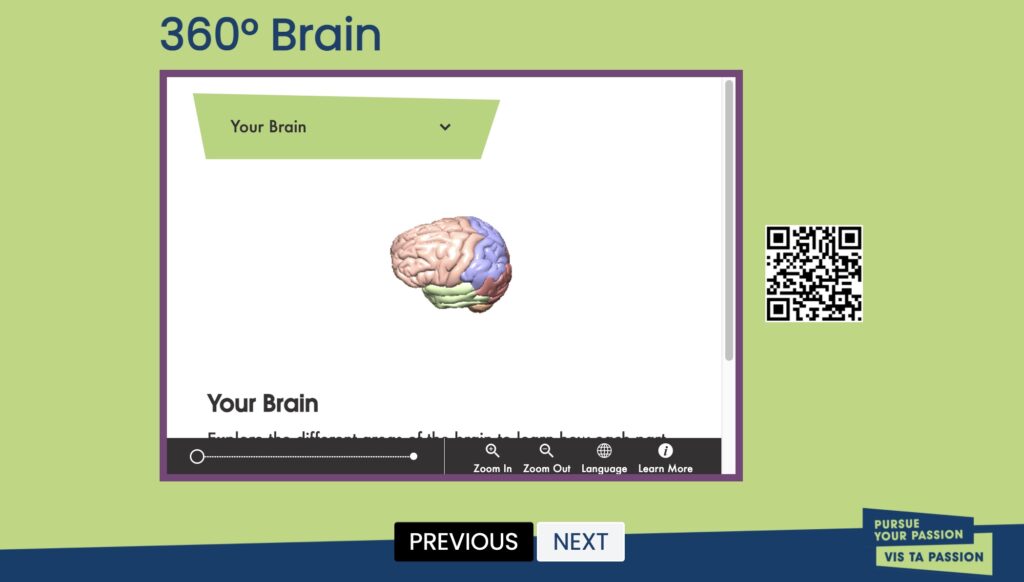
Teacher's Notes
“Here we will explore the different areas of the brain to learn how each part helps us all to function each and every day.
In this exercise we will focus on the areas of the brain that affect our thinking, planning and decision-making.
You can also scan the QR to take a look at the brain yourself.”
(Click on the dropdown and take the students through the Thinking & Planning sections. Read the info for each of the four sections in Thinking & Planning)
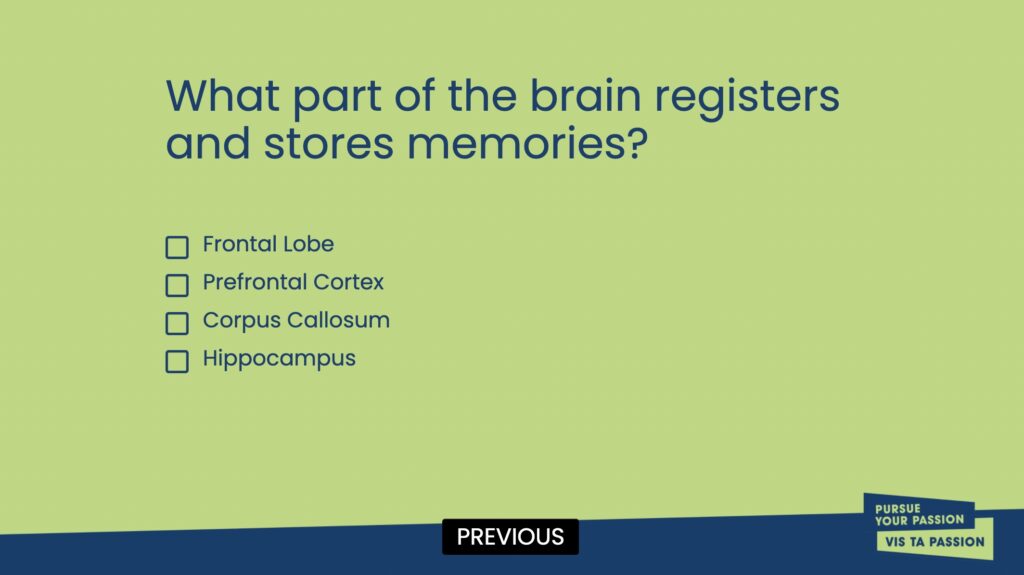
Teacher's Notes
“Pop quiz time…
What part of the brain registers and stores memories?
Frontal Lobe, Prefrontal Cortex, Corpus Callosum, or Hippocampus”
(Ask students to shout out what they think the correct answer is. Submit the most popular answer on behalf of all the students.)
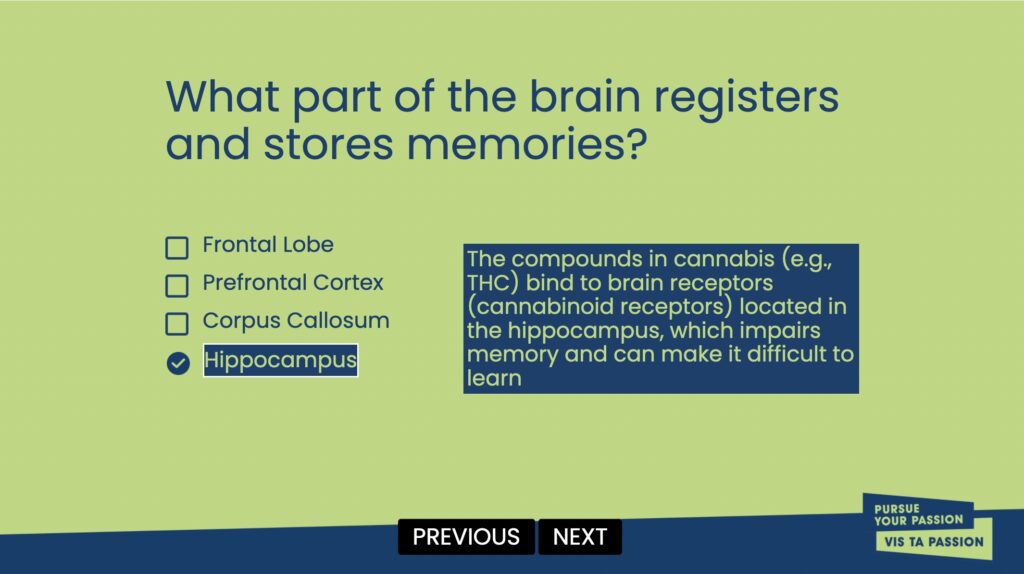
Teacher's Notes
“The correct answer is Hippocampus. The
compounds in cannabis (e.g., THC) bind to brain
receptors (cannabinoid receptors) located in the
hippocampus, which impairs memory and can make
it difficult to learn.”

Teacher's Notes
“Did you know that youth and young adults who consume cannabis, especially cannabis containing THC, are more likely to experience mental health problems?
This happens because cannabis can interfere with healthy brain development until your mid 20s.”
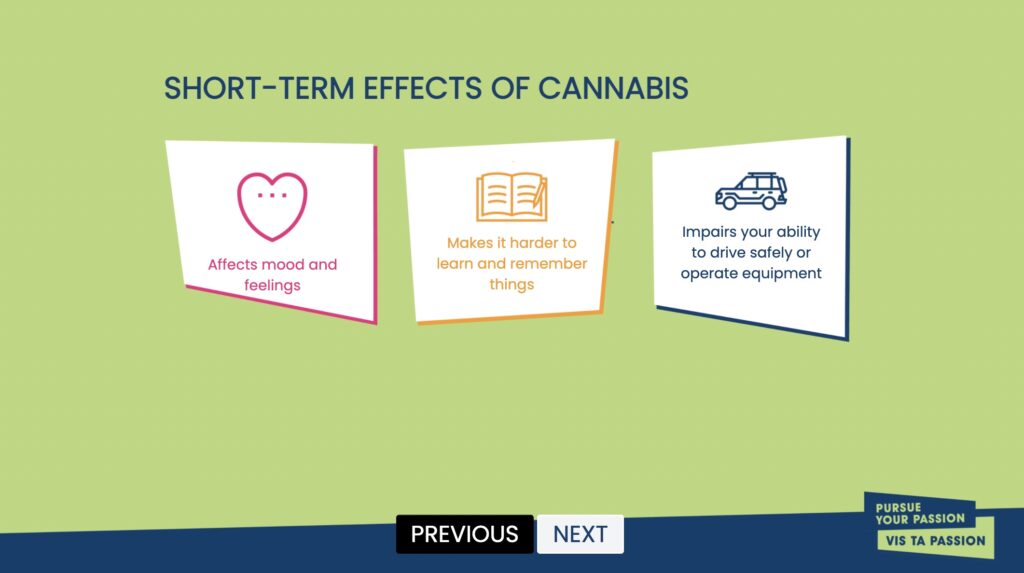
Teacher's Notes
“These are the short-term effects of using Cannabis”
Affects mood and feelings – While cannabis can make you feel relaxed and happy at times, it can also make you feel uncomfortable including feeling anxious, paranoid and depressed. Using cannabis products with higher THC levels (e.g., vape pens, shatter) can lead to greater levels of such negative effects.
Makes it harder to learn and remember things – After using cannabis, you may have problems paying attention, remembering or learning things, and making decisions. Using cannabis can reduce your ability to perform well on the job or at school.
Impairs your ability to drive safely or operate equipment – Driving is a complex task and requires the use of many areas of the brain. Cannabis can decrease your ability to react quickly, interferes with attention, and impairs coordination. If you know someone has consumed cannabis and intends to drive, do not get in a car with them.
Please consider a safer alternative to get yourself home. Call an Uber/ Lyft, taxi, or ask someone you trust to come and pick you up.”
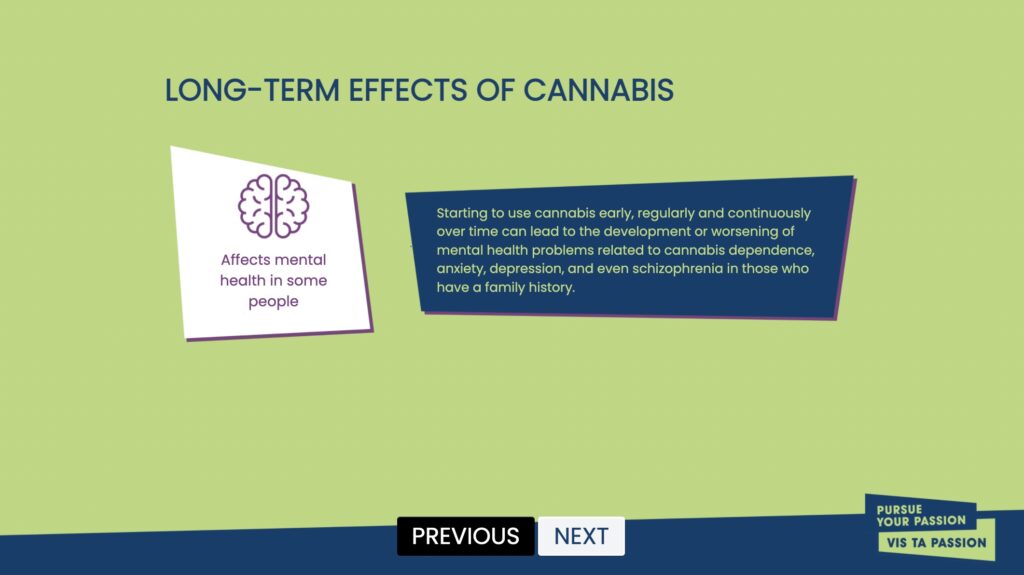
Teacher's Notes
“The long-term effects of using cannabis is that it affects mental health in some people.
Starting to use cannabis early, regularly and continuously over time can lead to the development or worsening of mental health problems related to cannabis dependence, anxiety, depression, and even schizophrenia in those who have a family history.”
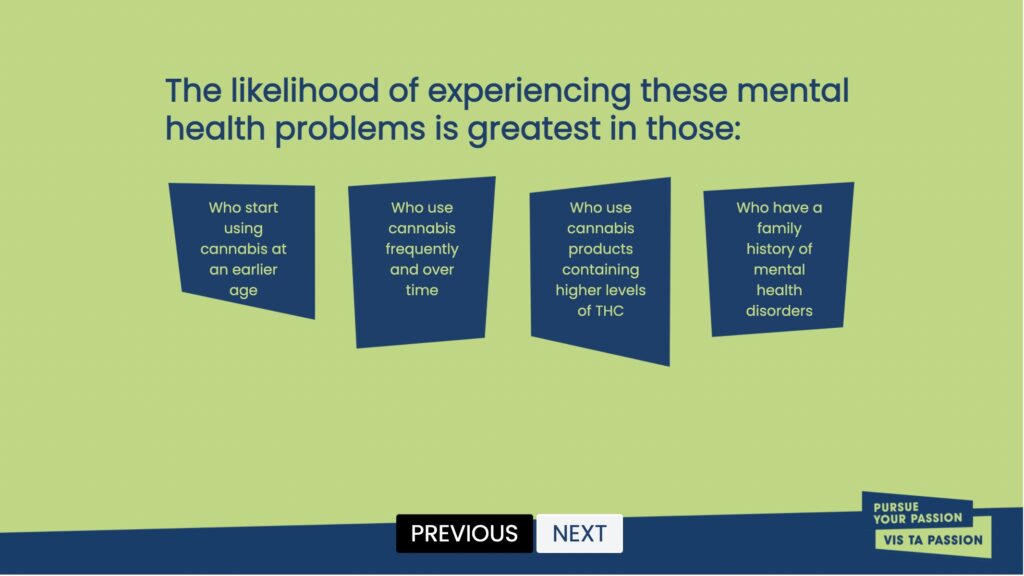
Teacher's Notes
“The likelihood of experiencing these mental health problems is greatest in those:
- who starting using cannabis earlier in age
- who use cannabis frequently and over time (i.e., daily or near daily)
- who use cannabis products containing higher levels of THC (e.g., 30-90% THC often found in vape pens and other cannabis extract products for ‘dabbing’)
- who have a family history of mental health disorders”
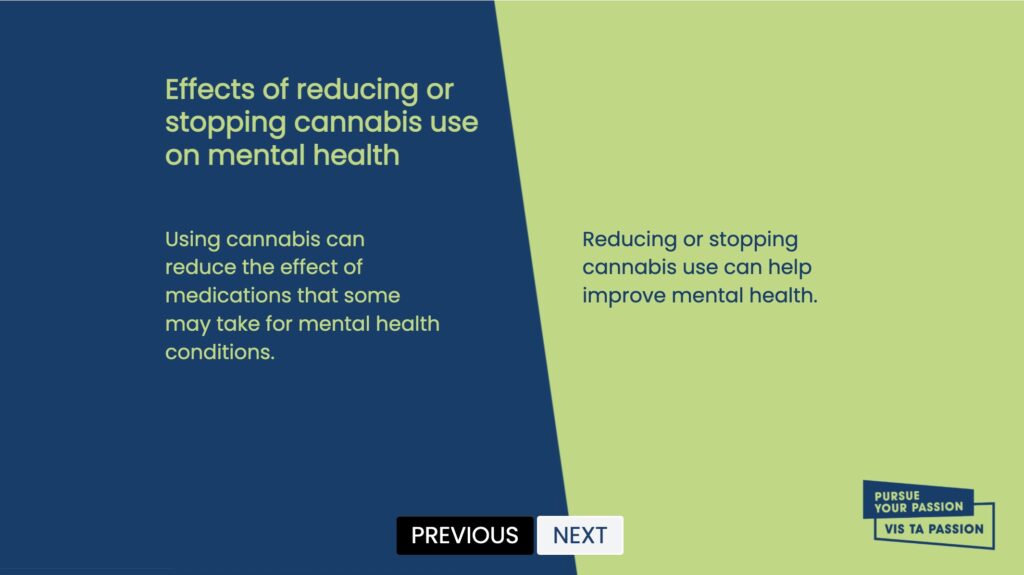
Teacher's Notes
“There’s evidence to suggest using cannabis can reduce the effect of medications that some may take for mental health problems (e.g., anxiety, depression) and can therefore limit your recovery potential. Evidence also shows that reducing or stopping cannabis use can help improve mental health.
Cannabis smoke contains similar chemicals found in tobacco smoke. Hence, smoking cannabis frequently increases risk of long-term harms to your heart and lungs.”

Teacher's Notes
“Name a short-term or long-term risk of using
cannabis”
(Ask students to shout out their answers)

Teacher's Notes
“With everything we just learned about the effects of cannabis, we now understand that it can have an impact on pursing the activities we love to do.
So, let’s explore some activities you can pursue that produce similar chemical reactions in the brain but in a healthier way!”

Teacher's Notes
“What are some activities you are passionate about?”
(Ask students to shout out their answers)
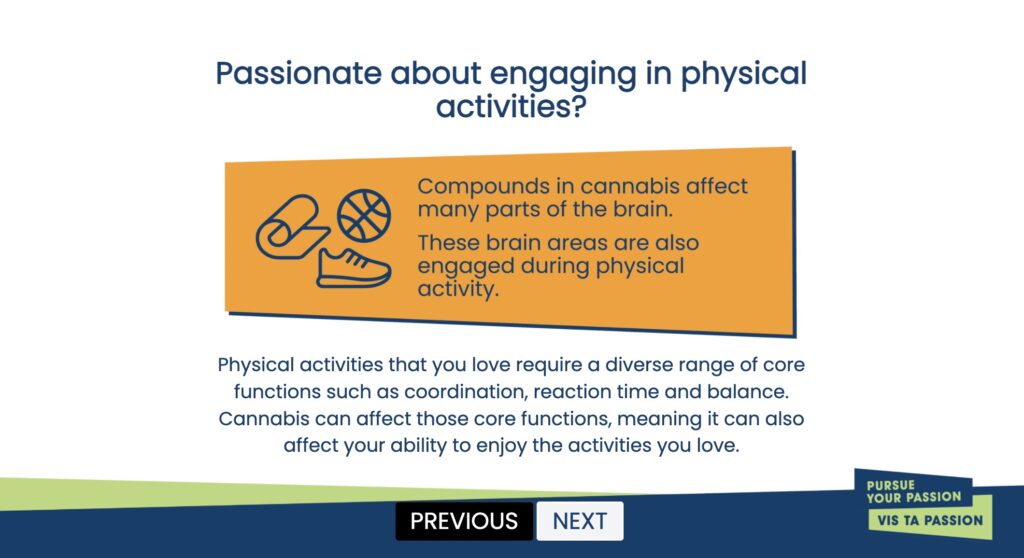
Teacher's Notes
“How many of you enjoy in engaging in physical activities?
Compounds in cannabis affect many parts of the brain. These brain areas are also engaged during physical activity.
Physical activities that you love require a diverse range of core functions such as coordination, reaction time and balance. Cannabis can affect those core functions, meaning it can also affect your ability to enjoy the activities you love.
Exercise can help alleviate feelings of anxiety and depression, and even help prevent mental health disorders from ever developing.
The brain stem controls breathing and heart rate, and the cerebellum, thalamus, basal ganglia and frontal lobe work together to control balance, coordination, movement, reaction time and decisionmaking.”

Teacher's Notes
“Name an activity that demonstrates the need for one or more of these:
- control
- balance
- coordination
- movement
- reaction time
- decision-making”
(Read out each option one at a time and ask students
to shout out their answers for each of the 6 options)
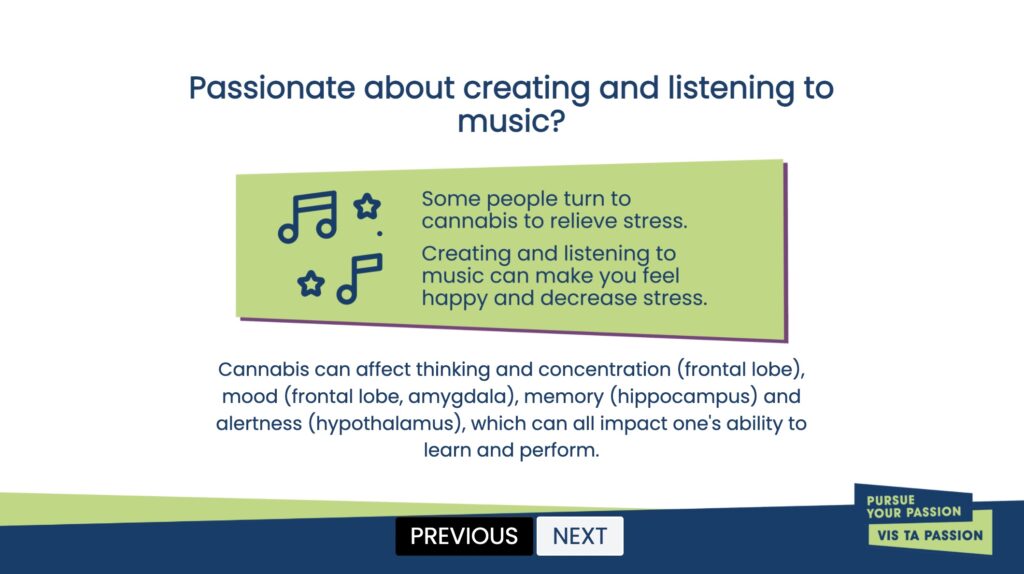
Teacher's Notes
“How many of you are passionate about creating or listening to music?
Some people turn to cannabis to relieve stress. Creating and listening to music can make you feel happy and decrease stress.
Cannabis can affect thinking and concentration (frontal lobe), mood (frontal lobe, amygdala), memory (hippocampus) and alertness (hypothalamus), which can all impact one’s ability to learn and perform.
Producing and listening to music triggers the release of the “feel-good” chemical dopamine within the brain’s frontal-temporal lobes and decreases the stress-causing hormone, cortisol.”
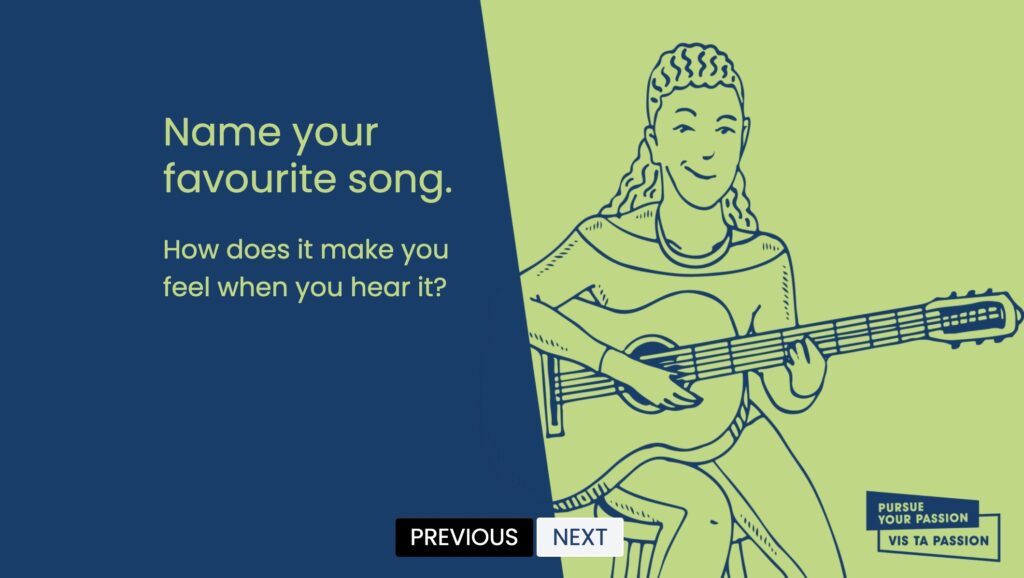
Teacher's Notes
“Name your favourite song.
How does it make you feel when you hear it?”
(Ask students to just shout out their answers)
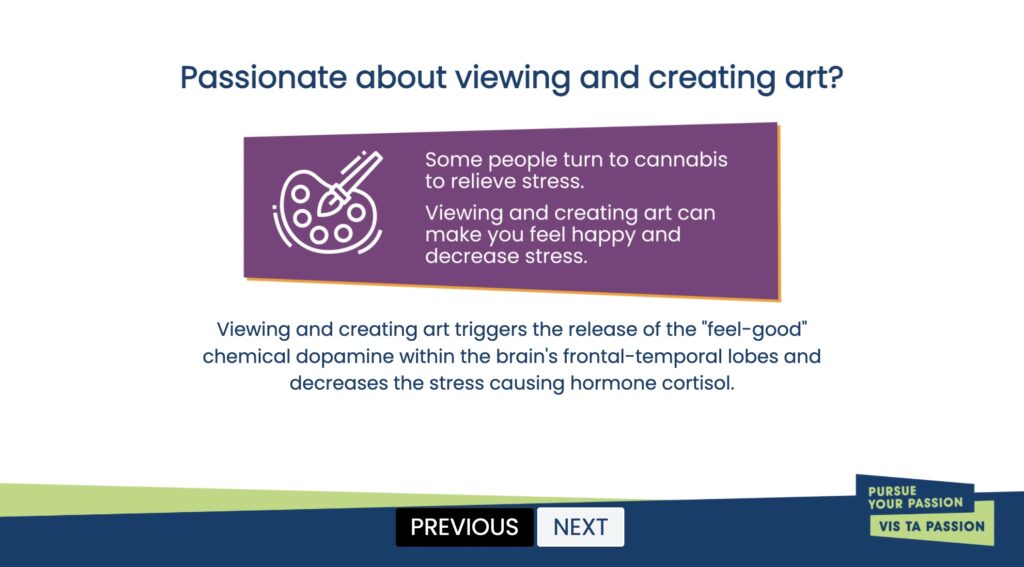
Teacher's Notes
“How many of you are passionate about creating or viewing art?
Some people turn to cannabis to relieve stress. Viewing and creating art can make you feel happy and decrease stress.
Similar to creating or listening to music…viewing and creating art triggers the release of the “feel-good” chemical dopamine within the brain’s frontaltemporal lobes and decreases the stress causing hormone cortisol.
Cannabis can affect thinking and concentration (frontal lobe), mood (frontal lobe, amygdala), memory (hippocampus) and alertness (hypothalamus), which can all impact one’s ability to be productive.”
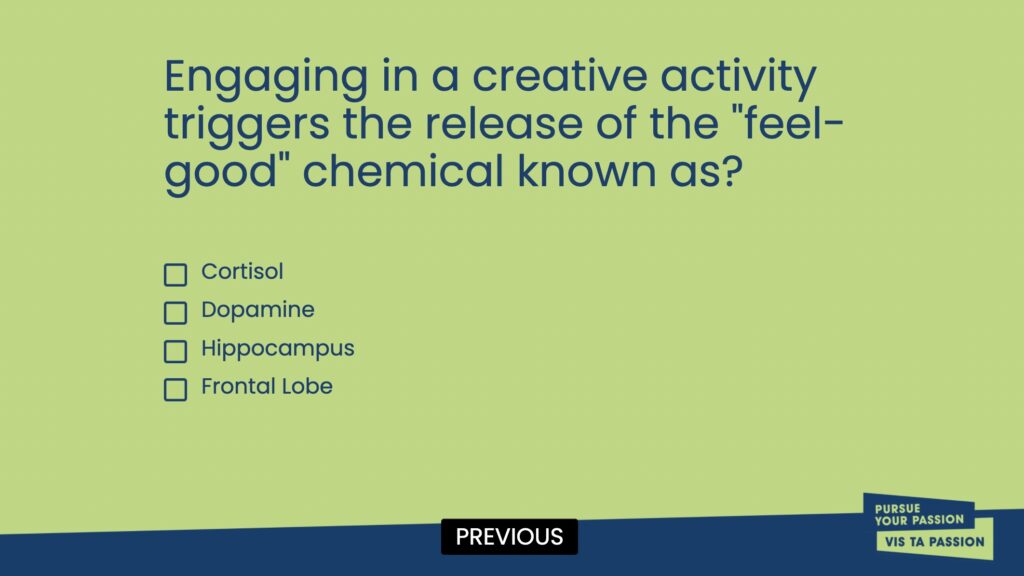
Teacher's Notes
“Quiz time again…
Engaging in a creative activity triggers the release of the “feel-good” chemical known as?
Cortisol, Dopamine, Hippocampus or Frontal Lobe”
(Ask students to shout out what they think the correct answer is. Then submit the most popular answer on behalf of all the students.)
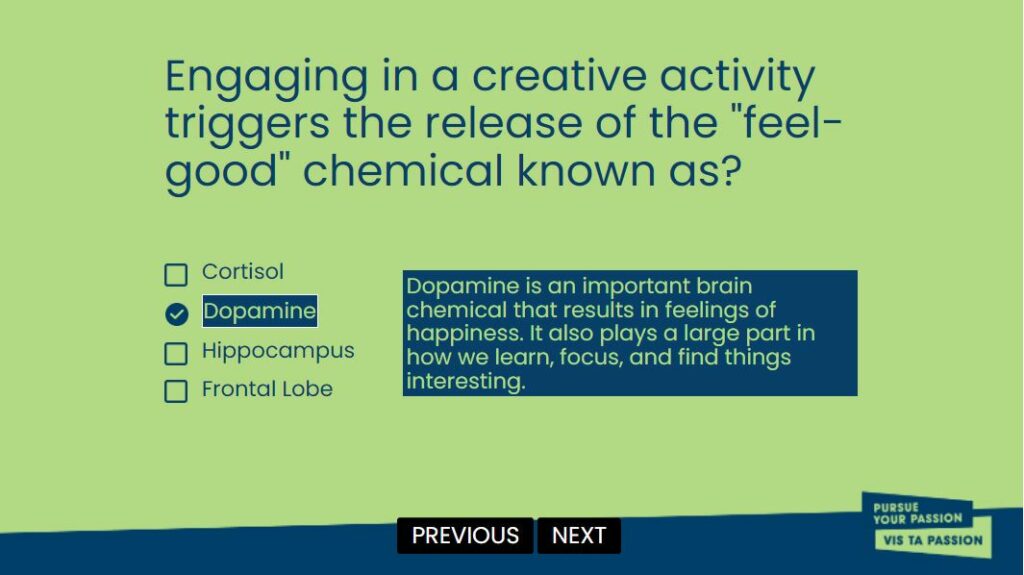
Teacher's Notes
“The correct answer is dopamine. Dopamine is an important brain chemical that results in feelings of happiness. It also plays a large part in how we learn, focus, and find things interesting.”
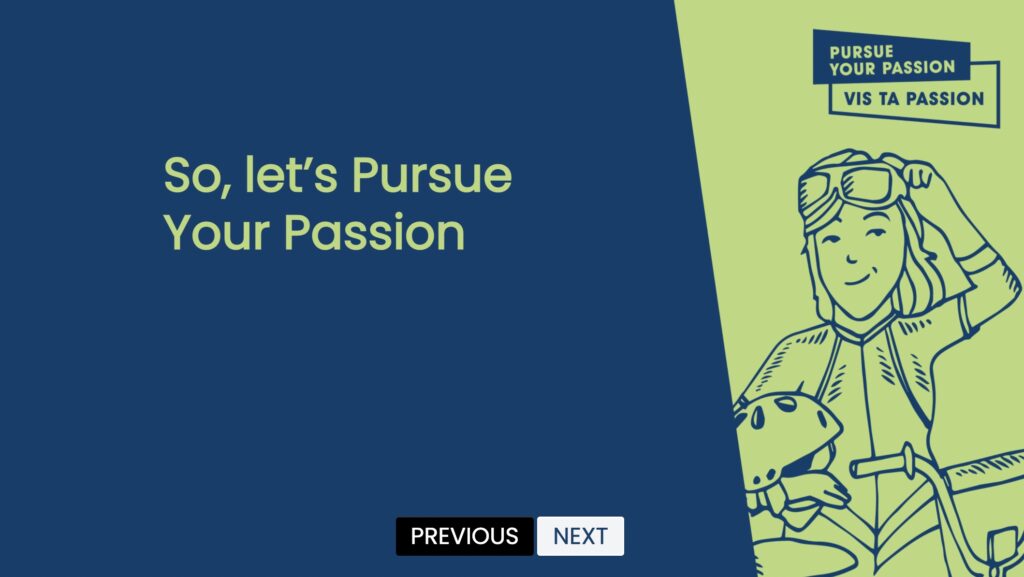
Teacher's Notes
“So, now let’s Pursue Your Passion!”
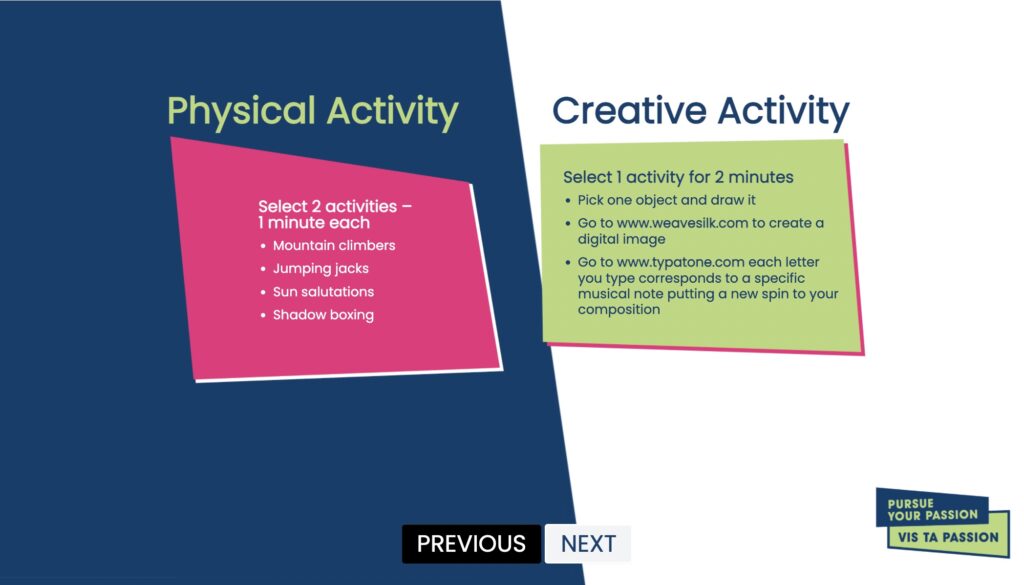
Teacher's Notes
“Everyone is going to choose either a physical activity or a creative activity. We will have a 2 minute challenge. For the physical activity you have an option of picking 2 out of these 4 exercises:
- Mountain climbers
- Jumping jacks
- Sun salutations
- Shadow boxing”
(If student chooses to pursue physical activities make sure they have adequate space to execute movements safely.)
“For the creative activity you can pick 1 activity out of these 3 activities:
- You can pick one object it and draw it
- Go to www.weavesilk.com to create a digital image
- Go to www.typatone.com each letter you type corresponds to a specific musical note putting a new spin to your composition”
(If student chooses to pursue creative activities, it’s important to note that 2 of the options require internet access. Make sure students are equipped with computers and internet access.)
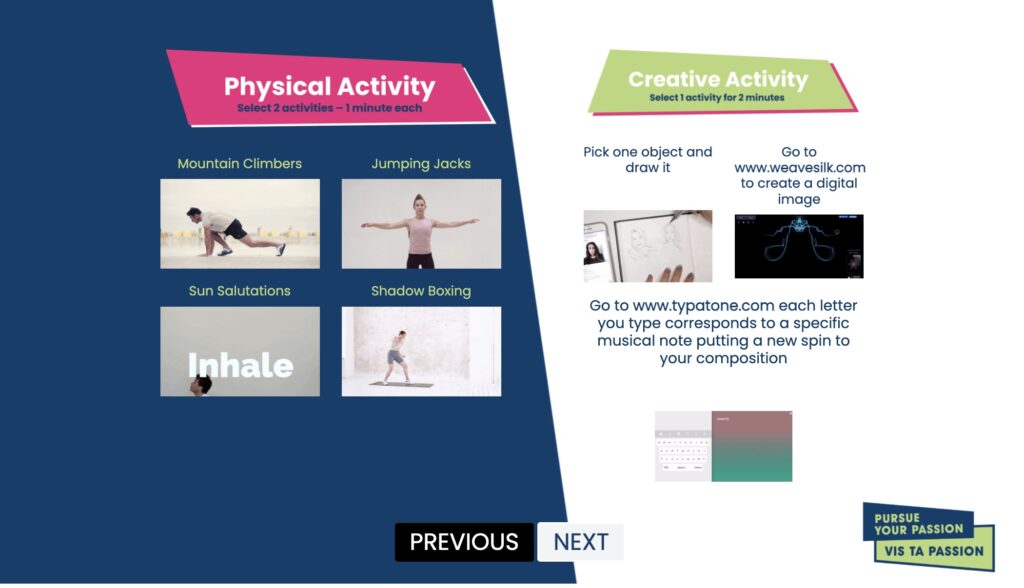
Teacher's Notes
“Here is what your activities will look like! You have 1 minute to decide which activities you’d like to pursue!”
(Give the students about 1 minute to think about which activity they will participate in.)
“Does everyone have an activity selected? I’m going to set up the 2 minute timer.”
(Set a two-minute timer. When you are ready let the students know)
“Ready, set, go!”
(1 minute into activity)
“1 minute left, if you’re doing a physical activity, it’s time to switch to your next move!”
(After 2 minutes)
“Time’s up! How do you feel?”
(Allow the students to share how they feel and encourage them to make linkages to the 360 Brain tool)

Teacher's Notes
“Frequent and long-term cannabis use can have a significant impact on brain development as well mental and physical health.
The best way to protect your health is to not use cannabis.
Engaging in physical activity, music, art, and other activities that you’re passionate about, can activate the same areas of the brain as cannabis, especially when trying to relieve stress or anxiety.”
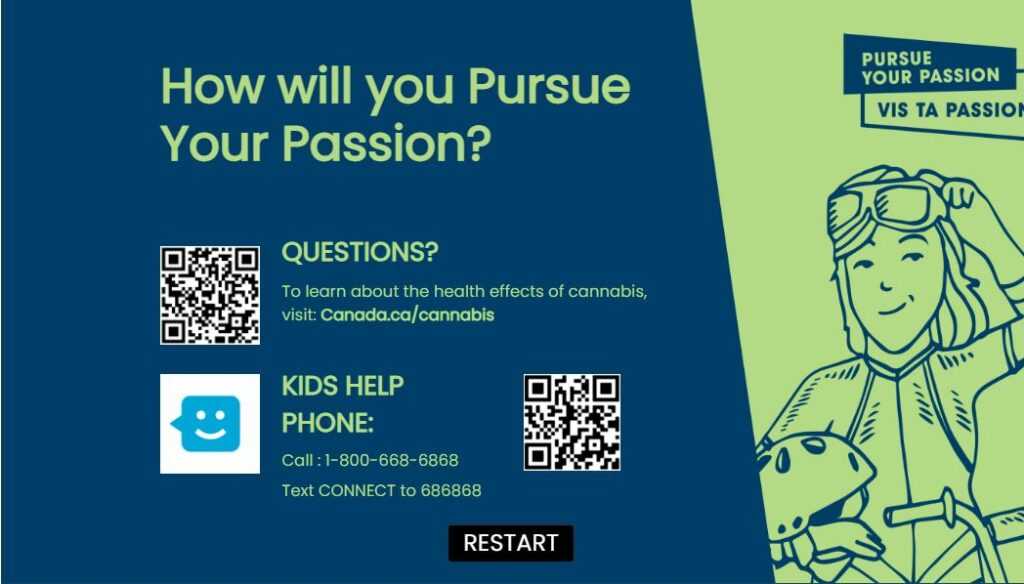
Teacher's Notes
“How will you Pursue Your Passion?
Scan the QR code to learn more about the health effects of cannabis or visit: Canada.ca/cannabis
Talking about cannabis and mental health can bring up strong emotions. If you or someone you know is struggling with, or has questions about, cannabis use and/or mental health, the Kids Help Phone can help. This service offers bilingual and confidential support by phone and text, 24/7, as well as live chat in the evenings.”

